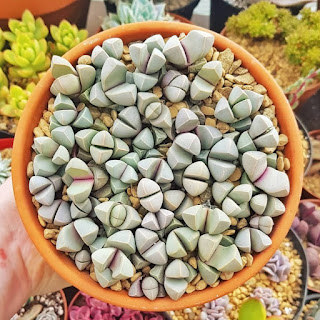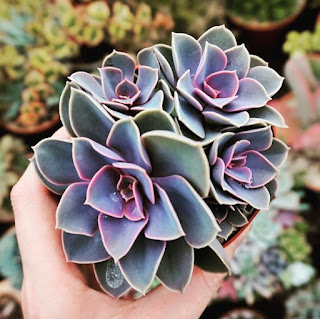A Guide to Caring for Lapidaria margaretae: The Living Pebble
Lapidaria margaretae, commonly known as the "Living Pebble" or "Karoo Rose," is a fascinating succulent that captivates plant enthusiasts with its unique appearance and low-maintenance requirements. Native to South Africa, this small, compact plant belongs to the Aizoaceae family and thrives in arid regions. If you're considering adding a Lapidaria margaretae to your collection, here's a comprehensive guide on how to care for this extraordinary succulent. If you would like to add this magnificent succulent to your collection you can buy one here.
Light Requirements:
Lapidaria margaretae is adapted to bright sunlight and requires at least 6 hours of direct sunlight daily. Place your Living Pebble near a south-facing window or in a location where it can receive plenty of bright, indirect light. However, be cautious of intense afternoon sun, especially in hotter climates, as it can lead to sunburn.
Soil and Potting:
A well-draining soil mix is essential for Lapidaria margaretae to prevent root rot. Use a mix of cactus potting soil or create your own blend with sand, perlite, and well-rotted compost. Ensure the pot has drainage holes to allow excess water to escape, preventing waterlogged soil. Small terracotta pots work really well for Lapidaria as they are breathable which helps to prevent rot.
Watering:
Like many succulents, the Living Pebble is adapted to survive in arid conditions and prefers infrequent but thorough watering. Allow the soil to dry out completely between waterings and water sparingly during the winter months when the plant is in a semi-dormant state. Overwatering is a common issue, so err on the side of underwatering to prevent root rot. If you need help a moisture meter takes away all of the guess work and tells you when your plant is dry.
Temperature and Humidity:
Lapidaria margaretae thrives in warm temperatures between 70°F to 85°F (21°C to 29°C) during the day and can tolerate cooler temperatures at night. It is crucial to protect the plant from frost, as it is not cold-tolerant. Additionally, this succulent prefers low humidity, making it well-suited for indoor environments.
Fertilizing:
During the growing season (spring and summer), feed your Living Pebble with a diluted, balanced fertilizer every 4-6 weeks. Avoid fertilizing in the fall and winter when the plant is in a dormant phase.
Propagation:
Lapidaria margaretae can be propagated from offsets or leaves. Gently separate offsets from the main plant and allow them to callous for a day or two before planting in a well-draining soil mix. Leaf cuttings can also be taken, left to dry for a day, and then planted in soil.
Pests and Diseases:
The Living Pebble is relatively resistant to pests and diseases, but it's essential to keep an eye out for common succulent pests like mealybugs and aphids. Treat any infestations promptly with insecticidal soap, neem oil or a systemic bug killer.
Conclusion:Caring for Lapidaria margaretae, the Living Pebble, can be a rewarding experience for succulent enthusiasts. By providing the right conditions of light, soil, water, and temperature, you can enjoy this unique and resilient plant as it thrives and adds a touch of natural beauty to your living space. Remember to observe your plant regularly, adjust care as needed, and enjoy the charming presence of the Living Pebble in your succulent collection.

.png)






